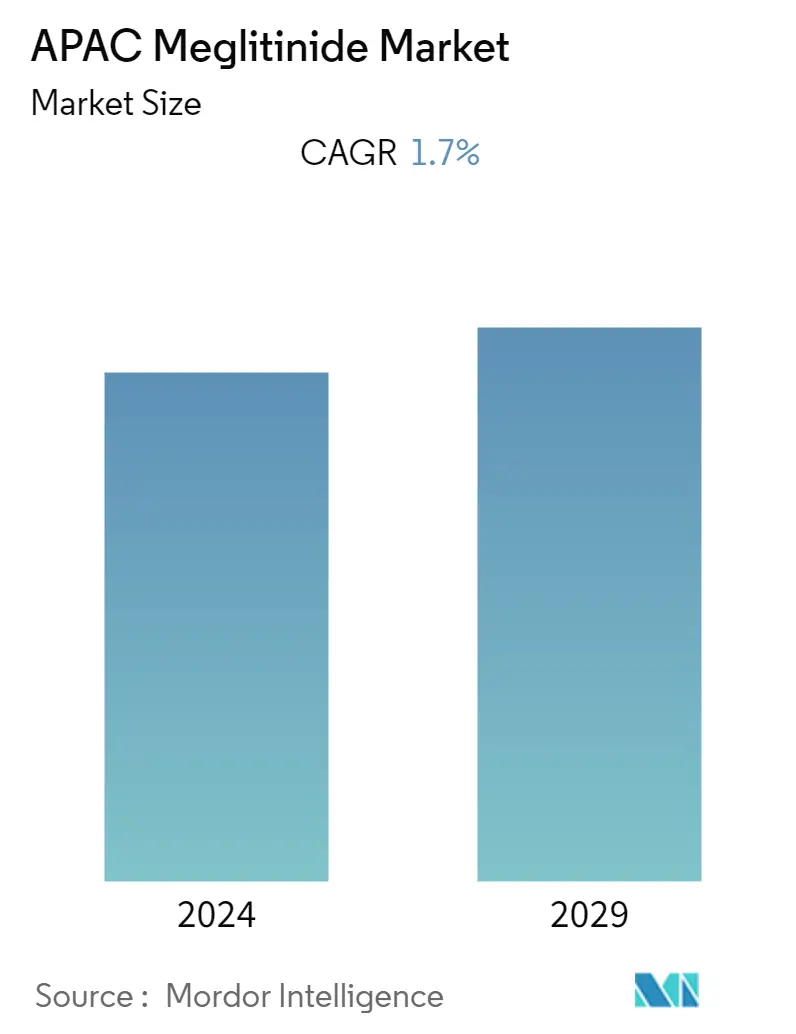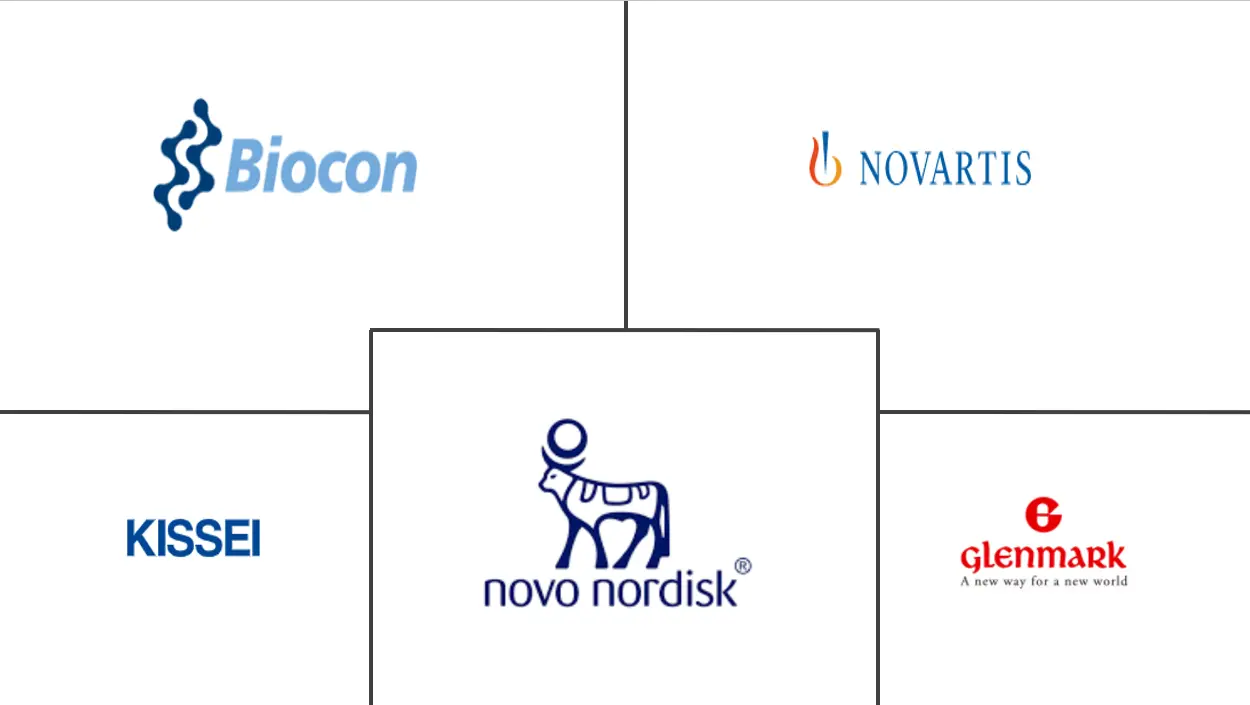Market Size of APAC Meglitinide Industry

| Study Period | 2018 - 2029 |
| Base Year For Estimation | 2023 |
| Forecast Data Period | 2024 - 2029 |
| Historical Data Period | 2018 - 2022 |
| CAGR | 1.70 % |
Major Players
*Disclaimer: Major Players sorted in no particular order |
APAC Meglitinide Market Analysis
The Asia-Pacific Meglitinide Market size is estimated at USD 1.62 billion in current year, and is expected to reach USD 1.76 billion by forecat year, growing at a CAGR of 1.70% during the forecast period.
People with Covid-19 had a statistically greater incidence of type 2 diabetes and other kinds of diabetes in the Asia-Pacific region. Individuals with no history of diabetes who recovered from SARS-CoV-2 infections have been reported to develop insulin resistance and reduced insulin secretion. It has been proposed that integrated rather than disease-specific methods are needed for post-Covid syndrome diagnosis and therapy.
Meglitinides are a type of non-sulfonylurea insulin secretagogues with a fast onset and short duration of action. They stimulate glucose-sensitive first-phase insulin release, lowering the risk of hypoglycemia. Meglitinides cause the body to release more insulin in people with type 2 diabetes, who have chronically high blood sugar levels. The World Health Assembly agreed on a Resolution to strengthen diabetes prevention and control in May 2021. It recommends actions such as increasing access to diabetes medicines and health products and assessing the feasibility and potential value of establishing a web-based tool to share information relevant to market transparency for diabetes medicines and health products.
The number of people with diabetes, especially type 2 diabetes, has increased rapidly in recent decades in Asian countries. Over 70% of the world's diabetic population lives in developing countries. The Asia-Pacific region is expected to witness significant growth with an aging population and increasing prevalence of diabetes, mainly due to increasing stress levels. A sedentary lifestyle, smoking, and excessive alcohol consumption, which raises blood sugar levels in the body, are contributing to the growth of this market. In addition, the manufacturing bases of certain anti-diabetic drug companies in the region also fueled the market growth. However, ever-increasing drug costs are considered to be one of the biggest restraining factors for the market. According to the OECD iLibrary, about 227 million people live with type 2 diabetes in the Asia-Pacific region, about half of whom remain undiagnosed and are unaware of the development of long-term complications. According to the International Diabetes Federation, by 2021, 90 million adults aged 20-79 will have diabetes in the Southeast Asia (SEA) region, with 113 million by 2030 and 152 million by 2030. expected to increase in humans. 2045 respectively.
This is driving the demand for Meglitinides in Asia-Pacific, thereby driving the market in focus during the forecast period.
APAC Meglitinide Industry Segmentation
Meglitinide derivatives are oral diabetes medications that help persons with type 2 diabetes mellitus (T2DM) manage their high blood sugar levels with a healthy diet and regular exercise. T2DM is a chronic medical disorder that makes it difficult for the body to manage the amount of sugar in the blood because it does not use insulin as it should. Controlling high blood sugar lowers the chance of heart attack and stroke, kidney disease, blindness, nerve damage, limb loss, and issues with sexual function. The Asia-Pacific Meglitinide Market is segmented by geography (Japan, China, South Korea, India, Australia, Vietnam, Malaysia, Indonesia, Philippines, Thailand, and the rest of Asia-Pacific). The report offers the value (in USD) and volume (in units) for the above segments. We will provide a segment-wise breakdown (value and volume) for all the countries covered under the Table of Contents.
| Drug | |
| Meglitinides |
| Geography | |
| Japan | |
| China | |
| South Korea | |
| India | |
| Australia | |
| Malaysia | |
| Indonesia | |
| Philippines | |
| Thailand | |
| Rest of Asia-Pacific |
APAC Meglitinide Market Size Summary
The Asia-Pacific Meglitinide Market is poised for growth, driven by the increasing prevalence of type 2 diabetes in the region. This rise in diabetes cases is attributed to factors such as urbanization, an aging population, and lifestyle changes, including sedentary habits and dietary shifts. Meglitinides, a class of non-sulfonylurea insulin secretagogues, play a crucial role in managing blood sugar levels by stimulating insulin release in response to glucose. The market is further bolstered by the region's manufacturing bases for anti-diabetic drugs and the global push for improved diabetes care and prevention, as highlighted by the World Health Assembly's resolutions. Despite the challenges posed by rising drug costs, the demand for effective diabetes management solutions continues to drive market expansion.
The market landscape is characterized by a competitive environment with key players like Novo Nordisk, Glenmark, and Novartis, who are actively engaged in technological innovations and product development to capture market share. The fragmented nature of the market is influenced by the presence of generic drug manufacturers, which adds to the competitive dynamics. Regulatory efforts and healthcare initiatives in countries like China aim to enhance diabetes care and reduce treatment costs, further supporting market growth. As the region grapples with a high burden of diabetes, the demand for meglitinides and other oral anti-diabetic medications is expected to rise, ensuring sustained market development over the forecast period.
APAC Meglitinide Market Size - Table of Contents
-
1. MARKET DYNAMICS
-
1.1 Market Overview
-
1.2 Drivers
-
1.3 Restraints
-
1.4 Porter's Five Forces Analysis
-
1.4.1 Bargaining Power of Suppliers
-
1.4.2 Bargaining Power of Consumers
-
1.4.3 Threat of New Entrants
-
1.4.4 Threat of Substitute Products and Services
-
1.4.5 Intensity of Competitive Rivalry
-
-
-
2. Market Segmentation
-
2.1 Drug
-
2.1.1 Meglitinides
-
-
2.2 Geography
-
2.2.1 Japan
-
2.2.2 China
-
2.2.3 South Korea
-
2.2.4 India
-
2.2.5 Australia
-
2.2.6 Malaysia
-
2.2.7 Indonesia
-
2.2.8 Philippines
-
2.2.9 Thailand
-
2.2.10 Rest of Asia-Pacific
-
-
APAC Meglitinide Market Size FAQs
What is the current APAC Meglitinide Market size?
The APAC Meglitinide Market is projected to register a CAGR of 1.7% during the forecast period (2025-2030)
Who are the key players in APAC Meglitinide Market?
Novo Nordisk, Glenmark, Novartis, Kissei and Biocon are the major companies operating in the APAC Meglitinide Market.

